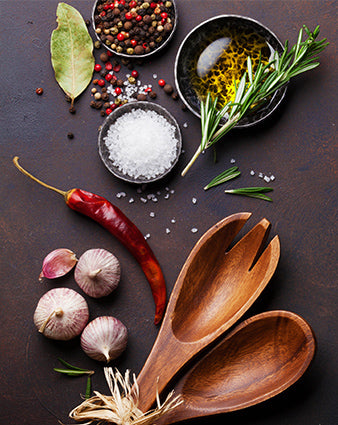The Science of Seasoning: The Magic Behind Flavourful Food 🧪 🔬
Picture this: you're sitting down to a delicious meal, and with the first bite, your taste buds do a happy dance. What's the secret behind this culinary enchantment? It's the wonderful world of seasoning, where science meets flavour in a delicious fusion of taste and chemistry. Join us as we uncover the tantalizing science behind the art of seasoning!
1. The Taste Buds Tango
To understand seasoning, we first need to delve into the science of taste. Our taste buds are like tiny flavour detectives, each specializing in a different aspect of taste:
-
Sweet: Located at the front of your tongue, these taste buds detect sugar and carbohydrates, like that delectable slice of cake.

-
Sour: Toward the sides of the tongue, these buds respond to acids, like lemons or vinegar.
-
Salty: Found across the tongue, these buds are sensitive to sodium, the element that gives salt its zing.
-
Bitter: Situated at the back of the tongue, these buds are on the lookout for bitterness, which can be found in foods like coffee or dark chocolate.
-
Umami: Discovered relatively recently, umami taste buds are thrilled by savoury, meaty flavours and are sensitive to glutamate, which is abundant in ingredients like soy sauce and Parmesan cheese.
When we season our food, we're essentially playing a symphony for these taste buds, creating a harmonious blend of flavours that dance across our palates.
2. The Power of Salt 🧂
Now, let's talk about the seasoning superstar: salt. Salt, in the form of sodium chloride, is like a culinary magician. It enhances the natural flavors of ingredients, making them more pronounced and enjoyable. But it's not just about making things taste saltier; salt can also suppress bitterness and balance out sweetness. It's a true multitasker in the world of seasoning.
3. The Aroma Adventure 👃
Ever wondered why a fragrant dish is so appealing? That's where aromas come into play. The smell of food is closely tied to our sense of taste, and it's the reason why your mouth waters when you catch a whiff of a sizzling steak or freshly baked bread. Aromas arise from volatile compounds in ingredients like herbs, spices, and even fats. When these compounds are released during cooking or seasoning, they travel through the air and into our noses, creating a sensory symphony that makes food irresistible.
4. The Magic of Herbs and Spices 🌿 🌶️
Herbs and spices are the seasoning superheroes. They're packed with unique flavour compounds that tantalize our taste buds and olfactory receptors. Take basil, for instance. It contains compounds like linalool and methyl chavicol, which give it its sweet, floral aroma and flavour. Meanwhile, black pepper boasts piperine, which delivers its characteristic heat.
The way these compounds interact with our senses is a scientific marvel. When we season our food with herbs and spices, we're essentially adding layers of complexity to our dishes, making them more interesting and irresistible.
5. The Culinary Alchemy 👩🍳
Cooking, too, plays a significant role in seasoning. The Maillard reaction, for instance, is a chemical process that occurs when amino acids and reducing sugars in food are subjected to heat. This reaction is responsible for the delightful browning and deepening of flavors in foods like seared steak, roasted coffee beans, and toasted bread.
So, there you have it—the science of seasoning in all its flavorful glory. The next time you sprinkle a pinch of salt, chop fresh herbs, or grind some black pepper onto your dish, remember that you're not just cooking; you're engaging in a delicious dance of science and artistry that transforms ordinary ingredients into extraordinary meals. So, go ahead and season with confidence, and let your taste buds savour the flavourful magic!







